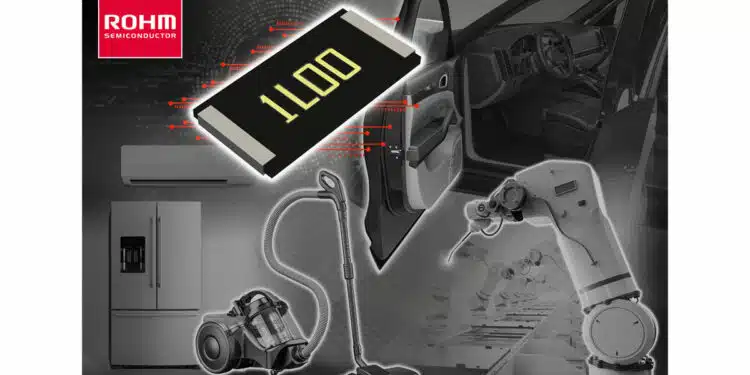ROHM’s New Shunt Resistors Contribute to Greater Miniaturization in Automotive, Consumer, and Industrial Equipment Applications.
ROHM Semiconductor announced three new products featuring a rated power of 5W in resistance values of 0.5mΩ, 1.0mΩ, 1.5mΩ have been added to the 2512-size (0.25 inch × 0.12 inch) / 6432-size (6.4mm × 3.2mm) PMR100 series of standard type metal plate shunt resistors.
These products are ideal for motor control and power circuits in automotive, consumer, and industrial equipment applications.
Shunt resistors for current detection are primarily used for power supply overcurrent protection, battery level detection, and in motor drive circuits in a wide range of fields, including the automotive, industrial equipment, and consumer electronics sectors.
To achieve the power savings required for various applications, precise circuit control using high accuracy, high reliability shunt resistors is necessary. In addition, as application functionality improves, boards are becoming denser, requiring smaller, higher power shunt resistors. Particularly in the automotive field, it is important to ensure high detection accuracy, even under high temperature environments.
These new products achieve a rated power of 5W by utilizing new materials with excellent temperature characteristics and terminal temperature derating. This represents the best-in-class for 6432-size flat chip types with protective film. Achieving approximately 2.5 times higher rated power than conventional PMR100 2W products and around 1.7 times higher than 3W models means it is possible to replace larger high-power types, contributing to greater miniaturization in a variety of applications.
Additionally, a rated terminal temperature of 130°C (for 0.5mΩ and 1mΩ products) and operating temperature range from -65°C to +175°C are guaranteed, ensuring stable operation, even in extreme temperature environments. An excellent temperature coefficient of resistance (TCR) of ±75ppm/°C enables reliable, high accuracy current detection.
ROHM continues to advance the development of resistors. By further increasing the power and resistance ranges, ROHM is able to expand the PMR100 series to include compact, high power, high temperature, high accuracy models, as well as 4W types in the smaller 1210-size (0.12 inch × 0.1 inch) / 3225-size (3.2mm × 2.5mm) and 2010-size (0.2 inch × 0.1 inch) / 5025-size (5.0mm × 2.5mm).
Going forward, ROHM will continue to contribute to the miniaturization and energy saving of applications by improving the performance of its broad family of shunt resistors.
PMR Series
The PMR series represents the most commonly used metal plate resistors among ROHM’s shunt resistor lineup. Seven industry-standard sizes are offered, ranging from 0402-size (0.04 inch × 0.02 inch) / 1005-size (1.0mm × 0.5mm) to 2512-size (0.25 inch × 0.12 inch) / 6432-size (6.4mm × 3.2mm). In addition, adopting a proprietary trimless structure suppresses the rise in product temperature caused by localized current concentration. This allows a wider distance between electrodes, improving the ease of pattern design even with resistances as low as 0.5mΩ.
Application Examples
The new products are universally compatible for current sensing in a wide range of applications.
- Automotive: EPS, electric compressors, oil/water pumps, door motors, ADAS controllers, etc.
- Industrial Equipment: Industrial power modules, power conditioners, power tools, PV inverters, server power supplies, UPS (Uninterruptible Power Supplies), base station power supplies, etc.
- Consumer applications: Home appliances (e.g., air conditioners, refrigerators, vacuum cleaners, washing machines) etc.
further topic reference: Overcoming the Challenges of Using Sub-Milliohm SMD Current Sense Chip Resistors































